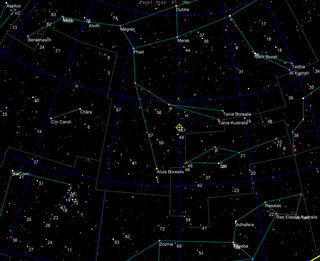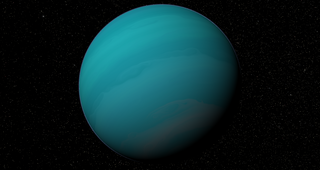
47 Ursae Majoris, formally named Chalawan, is a yellow dwarf star approximately 45.3 light-years from Earth in the constellation of Ursa Major. As of 2011, three extrasolar planets are believed to orbit the star.

Gliese 876 is a red dwarf star 15.2 light-years away from Earth in the constellation of Aquarius. It is one of the closest known stars to the Sun confirmed to possess a planetary system with more than two planets, after GJ 1061, YZ Ceti, Tau Ceti, and Wolf 1061; as of 2018, four extrasolar planets have been found to orbit the star. The planetary system is also notable for the orbital properties of its planets. It is the only known system of orbital companions to exhibit a near-triple conjunction in the rare phenomenon of Laplace resonance. It is also the first extrasolar system around a normal star with measured coplanarity. While planets b and c are located in the system's habitable zone, they are giant planets believed to be analogous to Jupiter.
HD 38529 is a binary star approximately 138 light-years away in the constellation of Orion.
HD 1237 is a binary star system approximately 57 light-years away in the constellation of Hydrus.

Iota Horologii b, often catalogued HR 810 b, is an extrasolar planet approximately 56.5 light-years away in the constellation of Horologium. Iota Horologii b has a minimum mass 2.26 times that of Jupiter; astrometric measurements from Gaia suggest it has a true mass of 6.2 MJ.

Gliese 876 b is an exoplanet orbiting the red dwarf Gliese 876. It completes one orbit in approximately 61 days. Discovered in June 1998, Gliese 876 b was the first planet to be discovered orbiting a red dwarf.

16 Cygni Bb or HD 186427 b is an extrasolar planet approximately 69 light-years away in the constellation of Cygnus. The planet was discovered orbiting the Sun-like star 16 Cygni B, one of two solar-mass (M☉) components of the triple star system 16 Cygni in 1996. It orbits its star once every 799 days and was the first eccentric Jupiter and planet in a double star system to be discovered. The planet is abundant in lithium.
Upsilon Andromedae d, formally named Majriti, is a super-Jupiter exoplanet orbiting within the habitable zone of the Sun-like star Upsilon Andromedae A, approximately 44 light-years away from Earth in the constellation of Andromeda. Its discovery made it the first multiplanetary system to be discovered around a main-sequence star, and the first such system known in a multiple star system. The exoplanet was found by using the radial velocity method, where periodic Doppler shifts of spectral lines of the host star suggest an orbiting object.

47 Ursae Majoris b, formally named Taphao Thong, is a gas planet and an extrasolar planet approximately 46 light-years from Earth in the constellation of Ursa Major. The planet was discovered located in a long-period orbit around the star 47 Ursae Majoris in January 1996 and as of 2011 it is the innermost of three known planets in its planetary system. It has a mass at least 2.53 times that of Jupiter.

14 Herculis b or 14 Her b is an exoplanet approximately 58.4 light-years away in the constellation of Hercules. The planet was found orbiting the star 14 Herculis, with a mass that would make the planet a Jovian planet roughly the same size as Jupiter but much more massive. It was discovered in July 1998 by the Geneva Extrasolar Planet Search team. The discovery was formally published in 2003. At the time of discovery it was the extrasolar planet with the longest orbital period, though longer-period planets have subsequently been discovered.

109 Piscium b is a long-period extrasolar planet discovered in orbit around 109 Piscium. It is about 5.74 times the mass of Jupiter and is likely to be a gas giant. As is common for long-period planets discovered around other stars, it has an orbital eccentricity greater than that of Jupiter.

Epsilon Eridani b, also known as AEgir [sic], is an exoplanet approximately 10.5 light-years away orbiting the star Epsilon Eridani, in the constellation of Eridanus. The planet was discovered in 2000, and as of 2023 remains the only confirmed planet in its planetary system. It orbits at around 3.5 AU with a period of around 7.6 years, and has a mass around 0.6 times that of Jupiter. As of 2023, both the Extrasolar Planets Encyclopaedia and the NASA Exoplanet Archive list the planet as 'confirmed'.
Gliese 317 is a small red dwarf star with two exoplanetary companions in the southern constellation of Pyxis. It is located at a distance of 49.6 light-years from the Sun based on parallax measurements, and is drifting further away with a radial velocity of +87.8 km/s. This star is too faint to be viewed with the naked eye, having an apparent visual magnitude of 11.98 and an absolute magnitude of 11.06.
Gliese 86 is a K-type main-sequence star approximately 35 light-years away in the constellation of Eridanus. It has been confirmed that a white dwarf orbits the primary star. In 1998 the European Southern Observatory announced that an extrasolar planet was orbiting the star.

GJ 3021 b, also known as Gliese 3021 b or HD 1237 b, is an extrasolar planet approximately 57 light-years away, orbiting its bright G-dwarf parent star in the Southern constellation of Hydrus. It was discovered with the Swiss Euler Telescope at the Chilean La Silla Observatory in 2000.
HD 210277 b is an extrasolar planet orbiting the star HD 210277. It was discovered in September 1998 by the California and Carnegie Planet Search team using the highly successful radial velocity method. The planet is at least 24% more massive than Jupiter. The mean distance of the planet from the star is slightly more than Earth's distance from the Sun. However, the orbit is very eccentric, so at periastron this distance is almost halved, and at apastron it is as distant as Mars is from the Sun.
Gliese 832 b is a gas giant exoplanet about 80% the mass of Jupiter, located 16.2 light-years from the Sun in the constellation of Grus, orbiting the red dwarf star Gliese 832.
Gliese 179 b is an extrasolar planet which orbits the M-type main sequence star Gliese 179, located approximately 40 light years away in the constellation Orion. This planet has a minimum mass somewhat less than Jupiter and it orbits at 2.42 AU from the star with an eccentricity slightly less than Pluto. The planetary distance ranges from 1.90 to 2.92 AU. This planet was discovered by using the radial velocity method from spectrograph taken at Keck Observatory on November 13, 2009. In 2023, the inclination and true mass of Gliese 179 b were determined via astrometry.
HD 175167 is a star with an exoplanet companion in the southern constellation of Pavo. It is too faint to be visible with the naked eye at an apparent visual magnitude of 8.01. The system is located at a distance of 232 light-years from the Sun based on parallax measurements, and it is drifting further away with a radial velocity of 5 km/s. It shows a high proper motion, traversing the celestial sphere at an angular rate of 0.190 arcsec yr−1.
HD 175167 b is an exoplanet orbiting HD 175167, which is a G type star within the Pavo constellation 232 light-years away from the Earth. The planet was discovered by the Magellan Planet Search Program as the astronomical object fit the Keplerian orbital model. During the observations 13 doppler velocity tests were conducted, which showed this object's mass was at least 7.8 Jovian-masses and its orbit has a high eccentricity. The exoplanet takes 3.53 years to complete a full stellar orbit.










